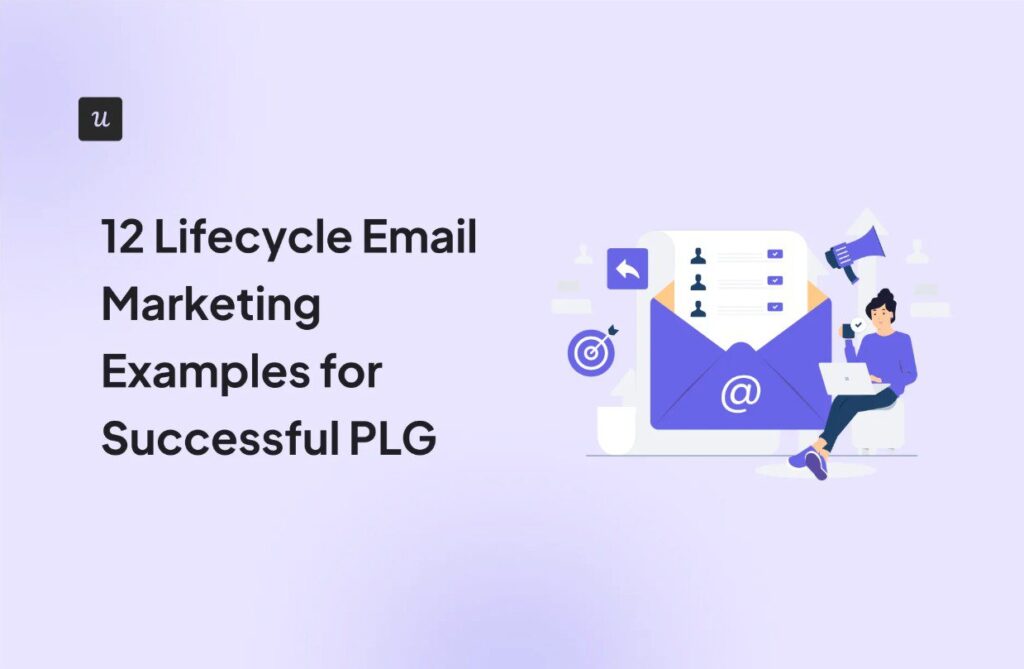
How do you improve the product experience and ensure users love interacting with every aspect of your tool?
That’s the focus of this article. We covered:
- The difference between product experience (PX) and customer experience (CX).
- Steps to track and measure PX.
- 11 strategies to improve PX across the user journey.
Get The Insights!
The fastest way to learn about Product Growth, Management & Trends.
TL;DR
- Product experience is the sum of a customer’s feelings, emotions, and perceptions as they interact with your product. In most companies, PX is spearheaded by product management teams. You can have different product managers handling various roles if the company is large enough.
- PX is focused on the user’s interaction with specific features of your tool. CX on the other hand, is much broader. It encompasses the entire user journey, from initial awareness to post-purchase interactions.
Delightful product experiences help to:
- Improve customer satisfaction across the user journey.
- Drive product adoption.
- Reduce churn and increase retention.
- Exceed customer expectations.
- Increase customer and brand loyalty.
How to track and measure PX:
- Perform path analysis
- Perform funnel analysis
- Track retention with cohort analysis
- Set up event tracking to monitor user engagement and product usage
- Collect customer feedback for quantitative and qualitative insights
- Gather insights on customer behavior from your customer support team and product managers
How to improve the product experience with 11 strategies
- Personalize the entire customer journey for new users
- Meet and exceed user expectations during user onboarding
- Provide contextual help with tooltips and help users complete tasks easily
- Create easy access to helpful resources
- Provide good customer service
- Follow up on negative customer feedback
- Have your customer success and product teams educate users on the value of the product
- Constantly monitor user behavior to identify and fix pain points
- Use session recordings to identify and fix bad user interface
- Perform usability tests to identify areas for improvement
- Use in-app announcements to introduce new features
Userpilot helps product teams collect in-app data and improve user experience. Book a demo now to begin.
What is product experience?
Product experience is the sum of a customer’s feelings, emotions, and perceptions as they interact with your product.
It’s essentially the story of how customers engage with the product, from the initial discovery and purchase to ongoing use and potential repurchase.
Product experience vs customer experience
People often use product experience and customer experience interchangeably, but there are slight differences between them.
Product experience is focused on the user’s interaction with specific features of your tool. It centers on practical aspects, like performance, usability, and interface design.
The key objective here is to ensure that the product meets or exceeds customer expectations, leading to customer satisfaction and increased usage.
Customer experience, on the other hand, is much broader. It encompasses the entire customer journey, from initial awareness to post-purchase interactions. This includes not only the product but also marketing, sales, support, and any other touchpoint the customer has with your company.
The primary goal of CX is to create a positive overall brand perception and increase customer loyalty.
Here’s a table showing more details on their differences.

Why creating a great product experience is important?
Delightful product experiences help to:
- Improve customer satisfaction: A smooth, intuitive, and enjoyable product experience leads to happy customers. When users can easily achieve their goals and feel positive about their interactions, they become more satisfied with the product and the brand behind it. This builds trust and fosters a positive customer relationship.
- Drive product adoption: Great experiences pique user interest and motivate them to explore all the features and functionalities of your product. This is especially important in markets with fierce competition, where the user experience can be a major differentiator.
- Reduce churn and increase customer retention: Customers who struggle with a product or have negative experiences are more likely to abandon it. By prioritizing a smooth and satisfying experience, you minimize frustration and encourage long-term engagement.
- Exceed customer expectations: By investing in behavior tracking and implementing changes to boost PX, you’ll consistently exceed user expectations and keep them happy.
- Increase customer and brand loyalty: When customers feel your product is tailored to their needs and offer a superior experience, their loyalty to the brand increases. This loyalty can be immensely beneficial, as loyal customers are more likely to purchase, expand their accounts, be less sensitive to price changes, and become long-term advocates.
How to track and measure product experience?
The product experience can be multifaceted and subjective, making it somewhat difficult to quantify. But you can’t go wrong with these strategies:
Perform path analysis
Path analysis allows the product team to visualize and understand the sequences of actions users take within the product.
Implement it using tools like Userpilot and analyze the results to identify areas that may be confusing or less intuitive.

Perform funnel analysis
Break down the customer journey into discrete steps (funnels) to easily track how they’re moving from one funnel stage to the other.
Identify drop-off points and conversion barriers in the user funnel and dig deeper to understand why.

Track customer retention with cohort analysis
Segment customers into groups (cohorts) based on their sign-up date, demographics, or behavior and track their retention rate over time.
A high retention rate means you’ve been consistently delivering a positive product experience. A consistent decline in monthly, weekly, or daily active users is a sign that you need to investigate further and find ways to improve product experience.

Set up event tracking to monitor user engagement and product usage
With tools like Google Analytics and Userpilot, you can monitor specific actions users take within the product, like clicking a button, completing a task, or using a particular feature.
By tracking how customers interact with your product, it becomes easy to identify underused features or UX mistakes interrupting the user experience.

Collect customer feedback for quantitative and qualitative insights
Customer feedback provides insights into how users perceive and experience your product.
This direct feedback can highlight areas of satisfaction as well as pain points that might not be immediately apparent through quantitative data alone.
Be strategic with your feedback surveys to get the most out of them. For instance, contextual surveys—like asking users about their experience with a feature immediately they finish engaging with it—provide quality data rather than leaving the survey for later.

Talk with your customer support team
Your customer support team is on the front line, directly interacting with users and experiencing their pain points firsthand. Regularly gather their insights on common issues, frequently asked questions, and user frustrations.
Encourage support agents to share positive feedback as well, highlighting features users love and moments of delight they encounter.
How to improve the product experience with 11 strategies
Ready to start enhancing your product experience? Implement these strategies:
Personalize the entire customer journey for new users
Personalization tailors the product experience to meet the specific needs and preferences of individual users.
It makes the user feel understood and valued, which can greatly enhance their engagement and satisfaction with your product.
How to create personalized experiences for new users? Use welcome surveys and in-app behavior tracking to gather data on their use case, pain points, and goals. Group users based on their characteristics and trigger separate flows for each segment.

Meet and exceed user expectations during user onboarding
Use data from your welcome survey to tailor the onboarding experience, focusing on the features and workflows most relevant to each user’s goals.
But don’t stop there. Offer resources such as webinars, tutorials, and guides that add value beyond the basic product functionality. With everything tailored to the user’s needs, they will have a delightful onboarding experience and be encouraged to continue exploring your tool.
Provide contextual help with tooltips
Tooltips provide on-the-spot guidance and clarification for users. This reduces confusion and helps users understand how to use your product more effectively.
The key is to make tooltips contextual—relevant information should appear just when the user needs it, ensuring a seamless and frictionless experience.
Keep your tooltip copy short and to the point. Use clear language so the user knows exactly what to do and why.
Example:

Create easy access to helpful resources
Resource centers empower users to find answers independently, reducing dependence on direct support and increasing satisfaction.
To make this work, you need to enrich your resource center with all the information users need to troubleshoot issues on their own. Include detailed help docs, FAQs, short video tutorials, and any relevant content you need to add.

Provide good customer service
Exceptional customer service is more than just pleasant interactions; it’s about resolving issues swiftly and efficiently. Three ways to provide good customer service:
- Implement self-service: Aside from a resource center, you can also have a chatbot to allow users to find immediate solutions to simple problems.
- Ticket sorting: Use Natural Language Processing (NLP) to categorize support tickets based on content, saving time and ensuring queries reach the right team.
- Short ticket resolution time: Optimize internal processes to handle tickets efficiently and minimize resolution times. Quick, personalized, and effective responses to queries help to improve user experience and satisfaction.
Follow up on negative customer feedback
Always acknowledge and respond to negative feedback, even if you can’t immediately address the issue. This demonstrates that you value user input and are committed to improvement.
It’s easy: Use specialized tools to set up automated emails or in-app messages that thank users for their feedback and assure them that you’re taking action.
Consider the screenshot below. Imagine you’re the user here. Wouldn’t you feel valued?

Educate users on the value of your product
Sometimes, your tool isn’t the problem; users just don’t understand how to effectively use and maximize it.
If you notice users aren’t engaging as much as expected, encourage your product teams to create webinars that showcase the product’s benefits and educate users on its full potential.
Trigger invitations to these educational resources within the product itself, based on user behavior and context. For example, invite a user to a webinar on a specific feature when they first try to use it.

Use session recordings to identify and fix bad user interface
Session recordings are like a window into the user’s actual interaction with your product. They can reveal issues like dead clicks (clicking where there’s no interaction), rage clicks (repeatedly clicking in frustration), and areas of the interface that users overlook.
By analyzing these recordings, you can identify patterns that suggest poor UI design or confusing features. This insight allows you to refine the interface, making it more intuitive and user-friendly.

Perform usability tests to identify areas for improvement
Regular usability testing is crucial for continuously improving the product experience. It helps you identify issues that might not be obvious through other forms of feedback.
Here are some usability testing methods to choose from (or combine)
- Guerilla testing: This method involves approaching people in public places like cafes or libraries and asking them to perform tasks using your product. It’s a quick and low-cost way to gather feedback on usability.
- Eye tracking: This test tracks where and how long a user looks at different screen areas, revealing what catches their attention and what they miss.
- Unmoderated remote usability testing: Users test the product in their own environment without a moderator, providing natural insight into their interaction with your tool.
- Lab usability testing: Unlike unmoderated tests, this one is done in a controlled environment and allows for detailed observation and analysis.
- 5-second test: This method involves showing users a UI for only five seconds and asking what they remember. It’s good for testing visual hierarchy and first impressions. However, it doesn’t provide insight into deeper usability issues like navigation or task completion.
- First-click testing: Implement this to understand if your UI is intuitive enough for users to find what they need fast.
- Card sorting: This is another test that lets you evaluate navigation and information hierarchy. Card sorting involves labeling cards and asking users to categorize them how they deem fit. For instance, if you’re testing information hierarchy for your project management tool, you can have cards labeled “dashboard,” “customer support,” “tasks,” “progress tracking,” etc., and perform card sorting exercises to see how most users expect the information to be arranged.
Use in-app announcements to introduce new features
One way to improve product experience is to regularly update your tool and add exciting new features.
However, don’t just roll out features and assume users will find them. Create buzz around what you just built: notify users days or weeks before the launch to build anticipation.
Then, once it’s out, trigger in-app announcements like the example below and guide users on maximizing the feature.

Conclusion
Refrain from making product changes based on what’s trending or what you feel the user will love.
Instead, ensure all your decisions are data-driven. This is why you need to regularly track user behavior and engagement data. By looking at behavior trends over time, it becomes easy to make quality decisions.
Userpilot can help. Our platform is built with robust analytics features to enable you to track funnels and user paths, perform retention cohort analysis, and so on. Book a demo now to start tracking data and find ways to improve the product experience.




